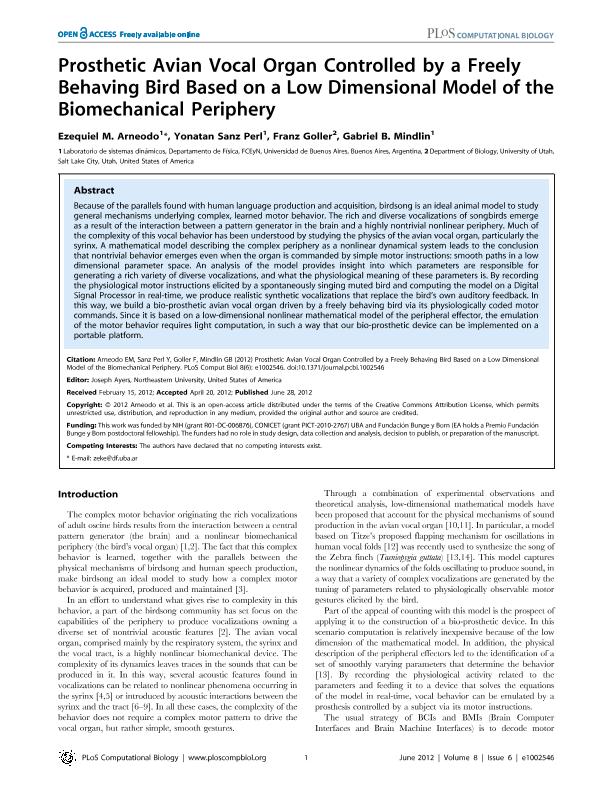Mostrar el registro sencillo del ítem
dc.contributor.author
Arneodo, Ezequiel Matías

dc.contributor.author
Sanz Perl Hernandez, Yonatan

dc.contributor.author
Goller, Franz

dc.contributor.author
Mindlin, Bernardo Gabriel

dc.date.available
2018-08-23T15:35:53Z
dc.date.issued
2012-06
dc.identifier.citation
Arneodo, Ezequiel Matías; Sanz Perl Hernandez, Yonatan; Goller, Franz; Mindlin, Bernardo Gabriel; Prosthetic Avian vocal organ controlled by a freely behaving bird based on a low dimensional model of the biomechanical periphery; Public Library of Science; Plos Computational Biology; 8; 6; 6-2012; 25461-254610
dc.identifier.issn
1553-734X
dc.identifier.uri
http://hdl.handle.net/11336/56799
dc.description.abstract
Because of the parallels found with human language production and acquisition, birdsong is an ideal animal model to study general mechanisms underlying complex, learned motor behavior. The rich and diverse vocalizations of songbirds emerge as a result of the interaction between a pattern generator in the brain and a highly nontrivial nonlinear periphery. Much of the complexity of this vocal behavior has been understood by studying the physics of the avian vocal organ, particularly the syrinx. A mathematical model describing the complex periphery as a nonlinear dynamical system leads to the conclusion that nontrivial behavior emerges even when the organ is commanded by simple motor instructions: smooth paths in a low dimensional parameter space. An analysis of the model provides insight into which parameters are responsible for generating a rich variety of diverse vocalizations, and what the physiological meaning of these parameters is. By recording the physiological motor instructions elicited by a spontaneously singing muted bird and computing the model on a Digital Signal Processor in real-time, we produce realistic synthetic vocalizations that replace the bird's own auditory feedback. In this way, we build a bio-prosthetic avian vocal organ driven by a freely behaving bird via its physiologically coded motor commands. Since it is based on a low-dimensional nonlinear mathematical model of the peripheral effector, the emulation of the motor behavior requires light computation, in such a way that our bio-prosthetic device can be implemented on a portable platform. © 2012 Arneodo et al.
dc.format
application/pdf
dc.language.iso
eng
dc.publisher
Public Library of Science

dc.rights
info:eu-repo/semantics/openAccess
dc.rights.uri
https://creativecommons.org/licenses/by-nc-sa/2.5/ar/
dc.subject
Birdsong
dc.subject
Prosthetic
dc.subject
Syrinx
dc.subject
Synthetic Sounds
dc.subject.classification
Astronomía

dc.subject.classification
Ciencias Físicas

dc.subject.classification
CIENCIAS NATURALES Y EXACTAS

dc.title
Prosthetic Avian vocal organ controlled by a freely behaving bird based on a low dimensional model of the biomechanical periphery
dc.type
info:eu-repo/semantics/article
dc.type
info:ar-repo/semantics/artículo
dc.type
info:eu-repo/semantics/publishedVersion
dc.date.updated
2018-08-21T18:35:00Z
dc.journal.volume
8
dc.journal.number
6
dc.journal.pagination
25461-254610
dc.journal.pais
Estados Unidos

dc.journal.ciudad
San Francisco
dc.description.fil
Fil: Arneodo, Ezequiel Matías. Universidad de Buenos Aires; Argentina. Consejo Nacional de Investigaciones Científicas y Técnicas. Oficina de Coordinación Administrativa Ciudad Universitaria. Instituto de Física de Buenos Aires. Universidad de Buenos Aires. Facultad de Ciencias Exactas y Naturales. Instituto de Física de Buenos Aires; Argentina
dc.description.fil
Fil: Sanz Perl Hernandez, Yonatan. Universidad de Buenos Aires; Argentina. Consejo Nacional de Investigaciones Científicas y Técnicas. Oficina de Coordinación Administrativa Ciudad Universitaria. Instituto de Física de Buenos Aires. Universidad de Buenos Aires. Facultad de Ciencias Exactas y Naturales. Instituto de Física de Buenos Aires; Argentina
dc.description.fil
Fil: Goller, Franz. University of Utah; Estados Unidos
dc.description.fil
Fil: Mindlin, Bernardo Gabriel. Universidad de Buenos Aires; Argentina. Consejo Nacional de Investigaciones Científicas y Técnicas. Oficina de Coordinación Administrativa Ciudad Universitaria. Instituto de Física de Buenos Aires. Universidad de Buenos Aires. Facultad de Ciencias Exactas y Naturales. Instituto de Física de Buenos Aires; Argentina
dc.journal.title
Plos Computational Biology

dc.relation.alternativeid
info:eu-repo/semantics/altIdentifier/url/http://journals.plos.org/ploscompbiol/article?id=10.1371/journal.pcbi.1002546
dc.relation.alternativeid
info:eu-repo/semantics/altIdentifier/doi/http://dx.doi.org/10.1371/journal.pcbi.1002546
Archivos asociados
